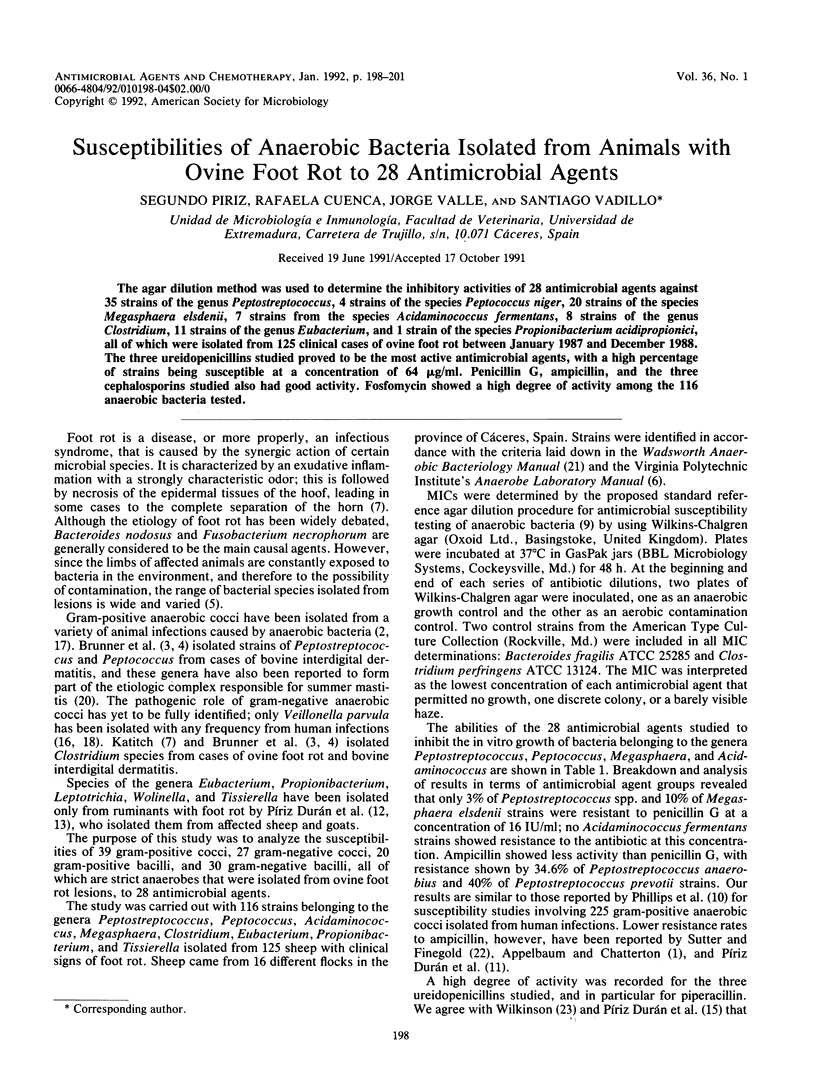Abstract
The agar dilution method was used to determine the inhibitory activities of 28 antimicrobial agents against 35 strains of the genus Peptostreptococcus, 4 strains of the species Peptococcus niger, 20 strains of the species Megasphaera elsdenii, 7 strains from the species Acidaminococcus fermentans, 8 strains of the genus Clostridium, 11 strains of the genus Eubacterium, and 1 strain of the species Propionibacterium acidipropionici, all of which were isolated from 125 clinical cases of ovine foot rot between January 1987 and December 1988. The three unreidopenicillins studied proved to be the most active antimicrobial agents, with a high percentage of strains being susceptible at a concentration of 64 micrograms/ml. Penicillin G, ampicillin, and the three cephalosporins studied also had good activity. Fosfomycin showed a high degree of activity among the 116 anaerobic bacteria tested.
Full text
PDF



Selected References
These references are in PubMed. This may not be the complete list of references from this article.
- Appelbaum P. C., Chatterton S. A. Susceptibility of anaerobic bacteria to ten antimicrobial agents. Antimicrob Agents Chemother. 1978 Sep;14(3):371–376. doi: 10.1128/aac.14.3.371. [DOI] [PMC free article] [PubMed] [Google Scholar]
- Berg J. N., Fales W. H., Scanlan C. M. Occurrence of anaerobic bacteria in diseases of the dog and cat. Am J Vet Res. 1979 Jun;40(6):876–881. [PubMed] [Google Scholar]
- Egerton J. R., Roberts D. S., Parsonson I. M. The aetiology and pathogenesis of ovine foot-rot. I. A histological study of the bacterial invasion. J Comp Pathol. 1969 Apr;79(2):207–215. doi: 10.1016/0021-9975(69)90007-3. [DOI] [PubMed] [Google Scholar]
- Katitch R. V. Les problèmes de l'étiologie et de l'immunoprophylaxie dans le piétin du mouton. Comp Immunol Microbiol Infect Dis. 1979;2(1):55–59. doi: 10.1016/0147-9571(79)90058-4. [DOI] [PubMed] [Google Scholar]
- Mandell W., Neu H. C. In vitro activity of CI-934, a new quinolone, compared with that of other quinolones and other antimicrobial agents. Antimicrob Agents Chemother. 1986 May;29(5):852–857. doi: 10.1128/aac.29.5.852. [DOI] [PMC free article] [PubMed] [Google Scholar]
- Phillips I., Warren C., Taylor E., Timewell R., Eykyn S. The antimicrobial susceptibility of anaerobic bacteria in a London teaching hospital. J Antimicrob Chemother. 1981 Dec;8 (Suppl 500):17–26. doi: 10.1093/jac/8.suppl_d.17. [DOI] [PubMed] [Google Scholar]
- Piriz Duran S., Cuenca Valera R., Valle Manzano J., Vadillo Machota S. Isolation and identification of anaerobic bacteria from ovine foot rot in Spain. Res Vet Sci. 1990 Sep;49(2):245–247. [PubMed] [Google Scholar]
- Piriz Duran S., Valle Manzano J., Cuenca Valera R., Vadillo Machota S. Obligately anaerobic bacterial species isolated from foot-rot lesions in goats. Br Vet J. 1990 Nov-Dec;146(6):551–558. doi: 10.1016/0007-1935(90)90059-c. [DOI] [PubMed] [Google Scholar]
- Piriz Duran S., Valle Manzano J., Cuenca Valera R., Vadillo Machota S. Susceptibilities of Bacteroides and Fusobacterium spp. from foot rot in goats to 10 beta-lactam antibiotics. Antimicrob Agents Chemother. 1990 Apr;34(4):657–659. doi: 10.1128/aac.34.4.657. [DOI] [PMC free article] [PubMed] [Google Scholar]
- Prescott J. F. Identification of some anaerobic bacteria in nonspecific anaerobic infections in animals. Can J Comp Med. 1979 Apr;43(2):194–199. [PMC free article] [PubMed] [Google Scholar]
- Sedallian A. Sensibilité des anaérobies à huit antibiotiques. Pathol Biol (Paris) 1986 Jun;34(5 Pt 2):645–647. [PubMed] [Google Scholar]
- Sorensen G. H. Studies on the occurrence of Peptococcus indolicus and Corynebacterium pyogenes in apparently healthy cattle. Acta Vet Scand. 1976;17(1):15–24. doi: 10.1186/BF03547939. [DOI] [PMC free article] [PubMed] [Google Scholar]
- Sutter V. L., Finegold S. M. Susceptibility of anaerobic bacteria to 23 antimicrobial agents. Antimicrob Agents Chemother. 1976 Oct;10(4):736–752. doi: 10.1128/aac.10.4.736. [DOI] [PMC free article] [PubMed] [Google Scholar]
- Wilkinson P. J. beta-Lactam antibiotics in the newborn. J Antimicrob Chemother. 1982 Feb;9 (Suppl B):21–29. doi: 10.1093/jac/9.suppl_b.21. [DOI] [PubMed] [Google Scholar]


